Jump to the following sections on this page:
The Campanile | Woodbine Cottage | Lincoln Memorial Library | Old Faithful | Coolidge Sylvan Theatre | SDSU Dairy Bar | Hobo Day | The Bummobile | Weary Wil and Dirty Lil | The Pride of the Dakotas Marching Band | The Cowbell | SDSU Fight Song | SDSU Alma Mater | The Jackrabbits | Aggies

The Campanile
South Dakota State University’s Coughlin Campanile has become one of South Dakota’s most famous landmarks. At the time of its completion in 1929, it was the tallest building in South Dakota. Throughout the years, Coughlin Campanile has become the premier symbol of SDSU.
Charles L. Coughlin, a 1909 alumnus, donated the funds to construct SDSU’s famous tower in celebration of the 20th anniversary of his graduation in electrical engineering. The final price for the campanile was $75,000.
The formal dedication of Coughlin Campanile took place following commencement ceremonies on June 13, 1930.
Coughlin Campanile is 165 feet high. It was built of white Indiana limestone, red brick, concrete and steel. There are 180 steps leading to the balcony floor, the highest point reached by visitors, which is 112 feet above the ground.
Coughlin Campanile closed for renovation during the spring of 2000. Many cosmetic improvements were made to repair the 70 years of weathering on the tower. It was reopened and rededicated Sept. 22, 2001.
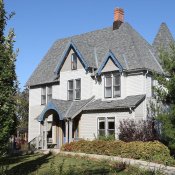
Woodbine Cottage
Lewis McLouth, SDSU’s second president, built this home and it was named Woodbine Cottage. After McLouth’s departure, the university bought the house and used it as a women’s dormitory and briefly as an infirmary. In 1903, it became the official home of the SDSU president. It remained the home of the SDSU president until 2017 when the new President’s Home was completed.
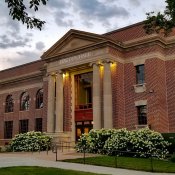
Lincoln Memorial Library
Lincoln Memorial Library was the first building in South Dakota constructed with funds gathered from a cigarette tax. It was also the first land-grant building in the nation named after President Abraham Lincoln.
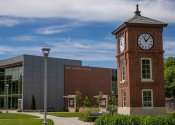
Old Faithful
“Old Faithful” sounded with pride from its new home atop the campanile. This bell had been taken from its former home in Old Central, SDSU’s first building, where it had sounded for nearly 40 years. “Old Faithful” was then moved to the Old North Clock Tower located beside Tompkins Alumni Center until 2016 when it was demolished to make room for the new Alumni Center and President’s Home.
The Alumni Center and President’s Home project included the installation of a new clock tower to replace that which was torn down. The bell was salvaged and reinstalled in its new home, The Tompkins Clock Tower, named in remembrance of the building that once stood on that site.
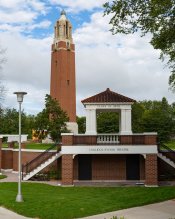
Coolidge Sylvan Theatre
Calvin Coolidge has been the only United States president to visit SDSU. In 1927, Coolidge dedicated this outdoor theatre and Lincoln Memorial Library. Ada B. Caldwell, an art professor, designed Coolidge Sylvan Theatre. The theatre is decorated with wrought iron gates, which were hand-forged on campus. Most graduations from 1928 to 1973 were held here. The stage is still used for plays and concerts and was the site of President Peggy Gordon Miller’s and President Barry H. Dunn’s inauguration in 1998 and 2016, respectively.

SDSU Dairy Bar
One of the most popular stops on campus for visitors and students is the SDSU Dairy Bar, which features the ever-famous SDSU ice cream. SDSU’s dairy program is unique in the fact that the plant is run by students.
With more than 100 flavors of ice cream, the dairy bar also produces cheese and butter. Approximately 10,000 pounds of milk are processed each week by the dairy plant. The SDSU Dairy Bar has provided a long-standing tradition of great products, as well as quality training and education for students.
Hobo Day
SDSU’s homecoming week culminates with Hobo Day. The week includes scheduled events such as Bum Olympics, Bum Over, Rally at the Rails and the Cavorts Talents Show.
The first Hobo Day was in 1912. It featured a torchlight parade where students dressed in their nightshirts and met their friends, family and returning alumni who were arriving on the nightly train. The next day, the men dressed like bums and the women as Native Americans. Together, they begged for ingredients from Brookings residents to make Bum Stew to feed their visitors.
Hobo Day starts with the Hobo Day Parade, where bands, floats and the Bummobile entertain an enthusiastic crowd. The parade is followed by the Hobo Day football game.
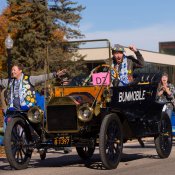
The Bummobile
One of the best-known elements of Hobo Day is the Bummobile. It is a 1912 Model-T Ford that was donated by Frank Weigel, a farmer from Flandreau. The Bummobile first appeared in the 1939 Hobo Day Parade and has remained an integral part of Hobo Day ever since.
When not adding to the Hobo Day festivities, the Bummobile is on display in the Hobo Day Gallery in the University Student Union.
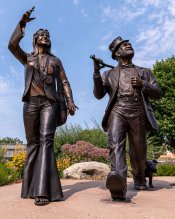
Weary Wil and Dirty Lil
Hobo Day is synonymous with two characters, Weary Wil and Dirty Lil. Weary Wil first appeared in a mural painting in the Jungle at Pugsley Union in the 40s and then was physically represented, for the first time, in 1950 by then student Walt Conahan. From 1950 forward, the Weary Wil moniker was known and used.
In 1976, Dirty Lil made her first appearance at Hobo Day. Lil’s character evolved out of a song written by the Hobo Day Committee. “Dirty Lil, Dirty Lil; Lived on top of a garbage hill; Never took a bath, never will; Dirty Lil.”
Wil and Lil serve as the symbol of all great Hobos. Both characters appear on SDSU’s campus throughout Hobo Week and are alumni of SDSU who were active as students on campus. Their identities remain a secret until halftime of the football game.
The Pride of the Dakotas Marching Band

The Pride is the most visible band at SDSU. In addition to performances during the pregame and halftime activities of all home Jackrabbits football games, The Pride has toured the Upper Midwest extensively, presenting shows at the Minnesota Vikings, Green Bay Packers and Winnipeg Blue Bombers football games and several guest performances at high school marching competitions in Minnesota, Iowa and South Dakota.
The Pride of the Dakotas is one of the largest “family” organizations on campus. Throughout the years, members of The Pride have forged friendships and memories that have lasted a lifetime.
The Pride’s rich history includes performances in the 1981 and 1997 Presidential Inaugural Parades, the 2000 National Independence Day Parade and the 2017 National Memorial Day Concert Series and Parade in Washington D.C. The Pride was also featured in the PBS production of “A Capitol Fourth,” and marched in the 2003 and 2008 Rose Parades. In 2011, The Pride was featured in the Fresh from Florida Parade in Orlando. In 2022, The Pride will proudly represent the university in the Macy’s Thanksgiving Day Parade.
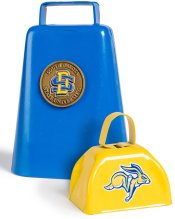
The Cowbell
Stemmed from the USD rivalry, the cowbell tradition goes back as far as the 1920s after students of USD referred to SDSC (South Dakota State College) as “cow college.” A story by John M. Ryan from a 1935 edition of the Collegian stated that Robert Bloedel ’28, a former captain of the cheer squad, felt that if SDSC was to be called “cow college” they might as well be proud of it. Bloedel asked President Charles Pugsley if State fans could bring cowbells to the game and use them to answer the taunts of the Coyotes.
SDSU Fight Song
(Ring The Bell)
Ring the Bell was written by Ken Carpenter, a music professor, and Stan Schleuter ’61 as an entry in a contest to find an upbeat fight song sponsored by the music department.
Ring the bell for South Dakota
The Yellow and the Blue;
Cheer the team from South Dakota
With loyal hearts so true;
Win the game for South Dakota
The school that serves us well;
We will fight for South Dakota
SO let’s ring, ring, ring those bells.
SDSU Alma Mater
(Yellow and Blue)
The Yellow and Blue was written by N.E. Hansen, a horticulture professor, with the help of Francis Haynes, a music professor, who put music to Hansen’s words.
We come from the Sioux and Missouri,
The Cheyenne and the Jim,
From pine-clad peaks of the Black Hills,
Brimful of vigor and vim,
We sing the song of the prairie,
The home of the Yellow and Blue.
The gleaming gold of the cornfield,
The flax of azure hue.
Oh, SDSU hurrah for the Yellow and Blue;
Old SDSU all honor and glory to you;
Forever raise the song in praise both loud and long
With loyal hearts so true (so true).
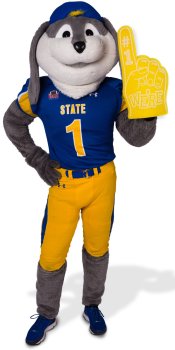
The Jackrabbits
Exactly how SDSU’s mascot became the Jackrabbit is a source of speculation; however, there are two theories about the origin. The first theory stems from a cartoon in the Minneapolis Star Tribune newspaper after the University of Minnesota and SDAC football teams played in 1905. The artist depicted the SDAC team as jackrabbits with the phrase, “The SDAC team was as quick as Jackrabbits.”
The second theory comes from SDSU’s yearbook, The Jack Rabbit. In 1907, a poem written by a group of juniors was featured in the yearbook. This poem changed the name of the yearbook from The Quirt to The Jack Rabbit. Many believe that following this, the athletic teams adopted the Jackrabbit as SDSU’s mascot.
Regardless of the origins of the name of the mascot, SDSU is the only college or university in the nation with a Jackrabbit as its mascot. Many coaches still believe that spotting a rabbit on the day of a contest ensures victory.
Aggies
From 1908 to 1960, the South Dakota School of Agriculture at Brookings educated young men and women from across South Dakota in a unique atmosphere. For five months of the year, students lived on the campus of South Dakota State College and took “practical” classes to prepare for life on the farm and in the home. As a replacement for their high school courses, the school primarily taught vocational agriculture and home economics but did not neglect traditional subjects such as English and arithmetic. Students took part in a full range of extracurricular activities and even published a newspaper. Aggies, as they were widely known, thus reaped the benefits of a high school education while still working at home or earning money to pay tuition for seven months of the year.
In the earliest years, enrollment in the school was very high. Both boys and girls were represented, and many students were older than average high school students. High schools were not common in rural South Dakota, and those that were available were often at quite a distance, requiring students to live away from home. The five-month calendar was particularly attractive to rural students, and the location at South Dakota State University made many older students feel less conspicuous.

